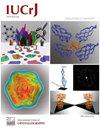蛋白质数据库中的无水结构。
IF 3.6
2区 材料科学
Q2 CHEMISTRY, MULTIDISCIPLINARY
引用次数: 0
摘要
存放在蛋白质数据库(PDB)中的高分辨率蛋白质晶体结构模型中没有溶剂分子,这与以下事实相矛盾:对于从水介质中结晶出来的蛋白质,水分子总是要结合到蛋白质表面以及蛋白质内部的某些位点上。对 PDB 内容的分析表明,在原子分辨率结构中,水分子数量与氨基酸残基数量的预期比率超过 1.5,在分辨率为 2.5 Å 左右时,这一比率降至 0.25。尽管如此,在当前发布的 PDB 中,仍有近 800 个以 2.5 Å 或更高分辨率测定的蛋白质晶体结构不含任何水分子,而其他一些沉积物的模型溶剂占有率则异常低或高。对这些沉积物的详细分析显示,溶剂分子的缺乏可能表明衍射数据、细化协议、沉积过程或这些因素的组合存在问题。据推测,溶剂结构问题应由 PDB 标记,并由沉积者解决。本文章由计算机程序翻译,如有差异,请以英文原文为准。
Waterless structures in the Protein Data Bank
A global analysis of protein crystal structures in the Protein Data Bank reveals many medium-to-high-resolution entries that lack any solvent molecules. Also, there are many cases with impossible occupancies of water molecules and/or uninterpreted very high difference electron-density peaks that indicate the presence of unmodeled water molecules.
The absence of solvent molecules in high-resolution protein crystal structure models deposited in the Protein Data Bank (PDB) contradicts the fact that, for proteins crystallized from aqueous media, water molecules are always expected to bind to the protein surface, as well as to some sites in the protein interior. An analysis of the contents of the PDB indicated that the expected ratio of the number of water molecules to the number of amino-acid residues exceeds 1.5 in atomic resolution structures, decreasing to 0.25 at around 2.5 Å resolution. Nevertheless, almost 800 protein crystal structures determined at a resolution of 2.5 Å or higher are found in the current release of the PDB without any water molecules, whereas some other depositions have unusually low or high occupancies of modeled solvent. Detailed analysis of these depositions revealed that the lack of solvent molecules might be an indication of problems with either the diffraction data, the refinement protocol, the deposition process or a combination of these factors. It is postulated that problems with solvent structure should be flagged by the PDB and addressed by the depositors.
求助全文
通过发布文献求助,成功后即可免费获取论文全文。
去求助
来源期刊

IUCrJ
CHEMISTRY, MULTIDISCIPLINARYCRYSTALLOGRAPH-CRYSTALLOGRAPHY
CiteScore
7.50
自引率
5.10%
发文量
95
审稿时长
10 weeks
期刊介绍:
IUCrJ is a new fully open-access peer-reviewed journal from the International Union of Crystallography (IUCr).
The journal will publish high-profile articles on all aspects of the sciences and technologies supported by the IUCr via its commissions, including emerging fields where structural results underpin the science reported in the article. Our aim is to make IUCrJ the natural home for high-quality structural science results. Chemists, biologists, physicists and material scientists will be actively encouraged to report their structural studies in IUCrJ.
 求助内容:
求助内容: 应助结果提醒方式:
应助结果提醒方式:


